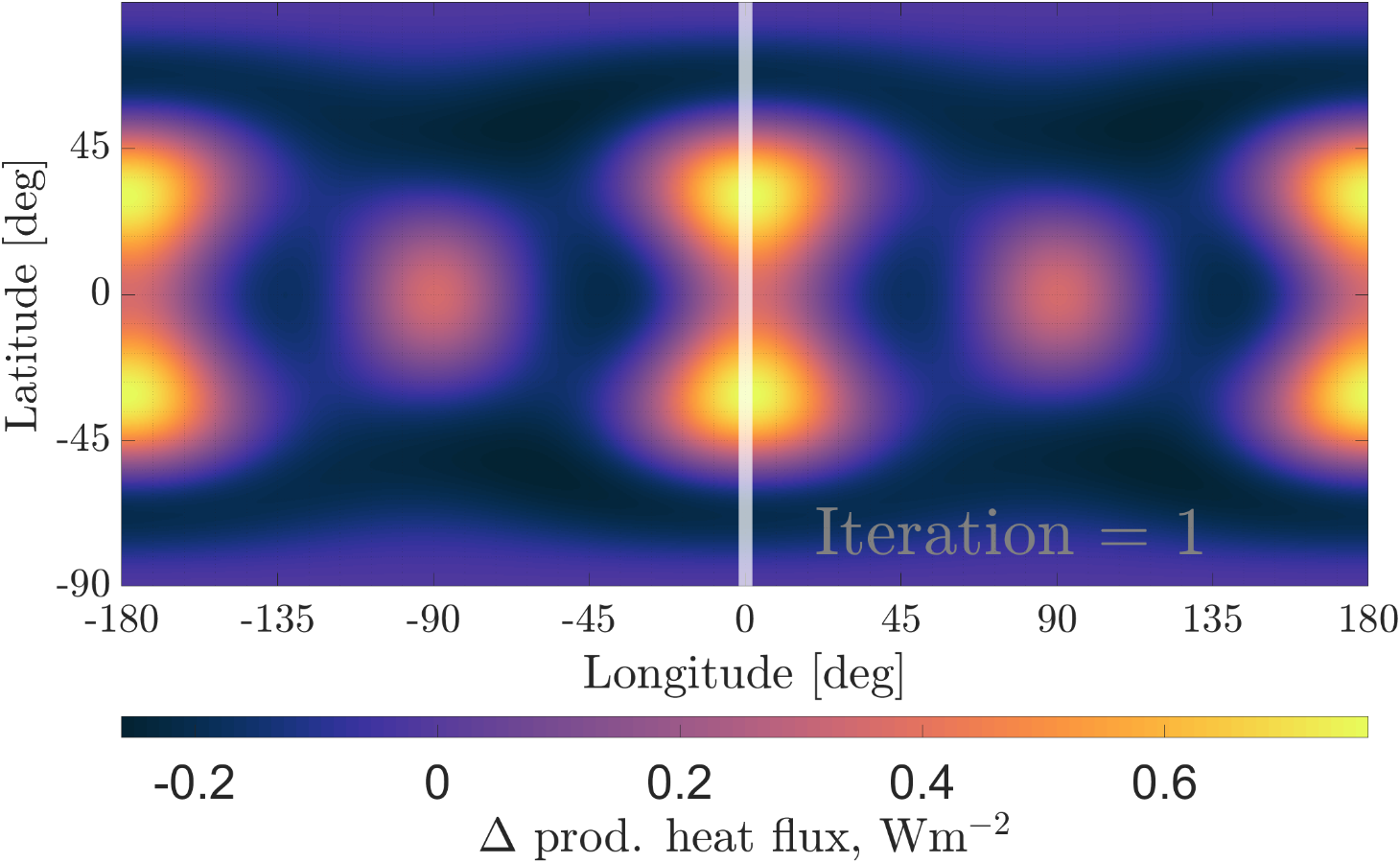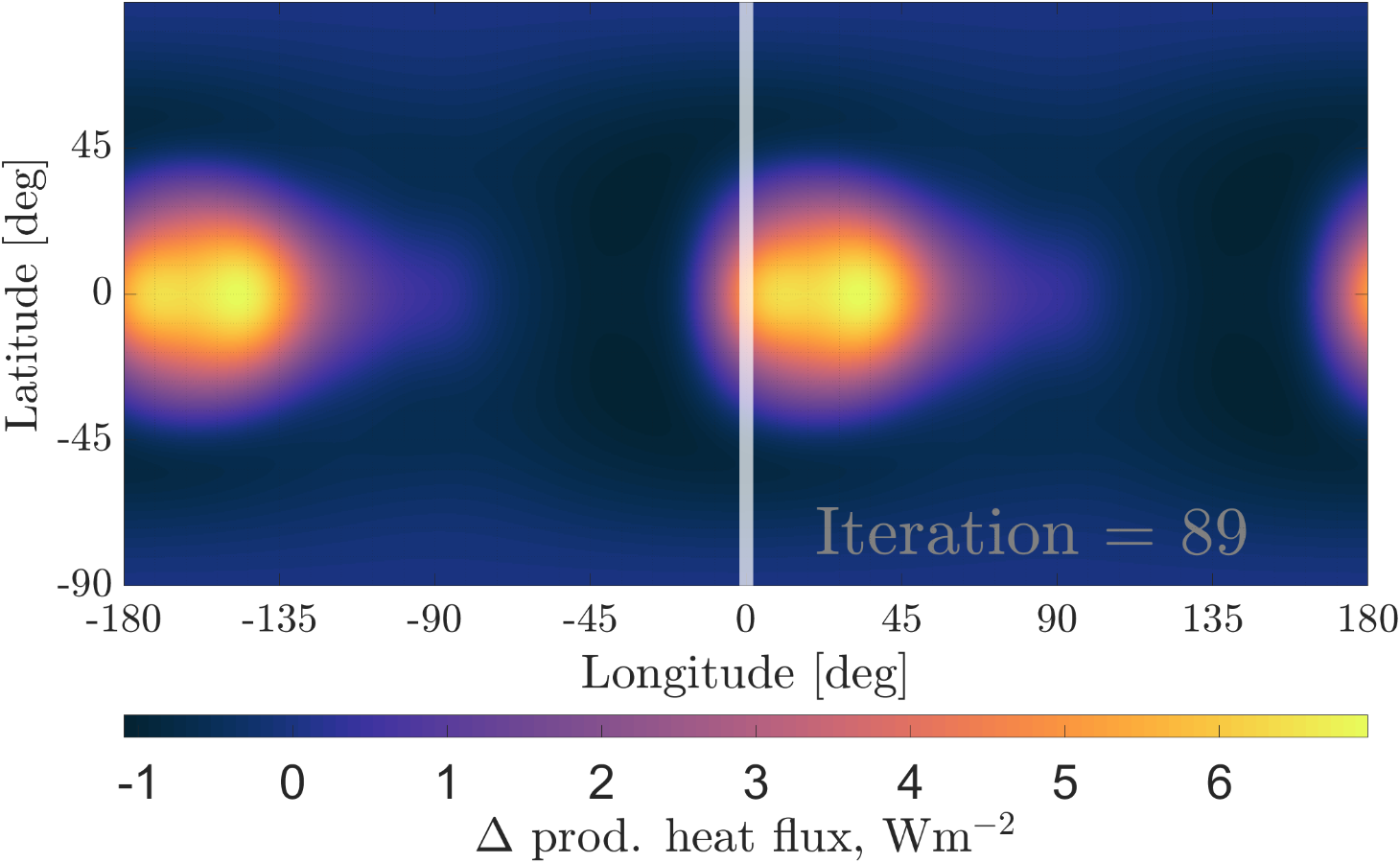Effect of tidal-heating on the rheology of Io
- Aerospace Engineering, Delft University of Technology, Delft, Netherlands (a.k.veenstra@tudelft.nl)
Introduction
Io exhibits widespread volcanism powered by tides raised by Jupiter. The distribution of volcanoes offers a window into the interior of the moon. The distribution shows more volcanism at the equator as well as peak volcanic output which is shifted by roughly 30-60 degrees to the east of the subjovian point [1]. Models of tidal dissipation that assume a spherically symmetric, solid Io cannot reproduce this shift [2]. More recently, it has been proposed that tidal dissipation in a magma ocean [3] or in a non-spherically symmetric, solid Io [4] can induce this lag. In this study, we explore the second option and show that solid-body dissipation can induce an eastward shift of the tidal dissipation pattern.
Method
The amount of tidal dissipation experienced by a planet or moon is a function of its interior properties (e.g. the shear modulus and viscosity). These properties depend on the body's thermal state, which for Io is mainly dictated by tidal heating. This results in feedback between interior properties and tidal response, modelling this requires coupling a thermal and tidal model. For the former, we parameterize the dependence of viscosity, η(θ, φ), and shear modulus, μ(θ, φ), on melt-fraction using laws derived from laboratory experiments and we assume that tidal dissipation and melt anomalies are linearly related by a factor c as δΦ(θ, φ) = c(θ, φ) δQ(θ, φ) [2]. The proportionality factor c(θ, φ) ranges between 0 and 0.06 [2] and its dependency on latitude and longitude mimics convection and other forms of lateral heat transport. In this work, we assume c=0.015 and consider that heating patterns of spherical harmonic degrees higher than 4 are blurred by such processes [5].
We compute tidal dissipation using the spectral code LOV3D [6]. We assume there is only tidal heating in the asthenosphere [1] and set the rheological properties such that the dissipation results in an average surface heat flux consistent with observations, at 2.4 Wm-2 [7]. We further assume that the asthenosphere has a globally constant, average melt-fraction of 10% [8].
We aim to obtain a steady state. To do so we first convert the tidal dissipation pattern of a uniform Io into a map of viscosity and shear modulus anomalies. The resulting maps are used to recompute tidal heating and iterate. To ensure a steady state and prevent runaway heating, we normalize the tidal dissipation pattern such that the average does not vary between iterations.

Results
Figure 1 shows the difference in surface heat flux, which is the radially integrated tidal dissipation, after one iteration compared to the initial pattern. The pattern shows a slight shift to the east of the anti-subjovian point, located at zero degrees longitude. Additionally, the local increase in melt-fraction induces higher peak-to-peak variations of tidal heating.
After 89 iterations, a steady solution is found and we retrieve a difference in surface heat flux as shown in Fig. 2. The eastward shift has grown to roughly 35 degrees at the equator, and the peak-to-peak variations have also grown. Tests with different values for c and other coupling methods, not shown here, also show this eastward shift but the resulting pattern can be different. In general, a stronger coupling between dissipation and melt-fraction, represented by a higher c, causes a larger shift and bigger peak-to-peak values which is consistent with previous results that used finite element modelling [4].
Given that we started with a spherically symmetric interior it might be surprising that an asymmetry arises. We suspect the cause for the eastward shift is an inherent asymmetry in the forcing since the tidal potential can be represented as having an eastward and westward propagating component, of which the eastward component has a larger amplitude [9]. To confirm this, we set the amplitude of the westward and eastward components to the same value and no longer observe a shift.
Overall, our results show that the feedback between tidal heating and rheology can induce an eastward lateral shift in tidal heating and hence melt-fraction. This demonstrates that solid-body tides can account for the observed eastward shift in the volcanic heat flow pattern which is especially relevant in anticipation of Juno’s measurement of Io’s k2 Love number, which could confirm or rule out the presence of a magma ocean. Our results are not particular to Io, hence suggesting that the same mechanism might lead to 3D structure in tidally heated exoplanets and exomoons.

[1] Davies, A. G., Perry, J. E., Williams, D. A., & Nelson, D. M. 2024, Nature Astronomy, 8, 94; [2] Steinke, T., Hu, H., H ̈oning, D., van der Wal, W., & Vermeersen, B. 2020a, Icarus, 335, 113299; [3] Tyler, R. H., Henning, W. G., & Hamilton, C. W. 2015, The Astrophysical Journal Supplement Series, 218, 22; [4] Steinke, T. 2021, PhD thesis, Delft University of Technology; [5] Beuthe, M. 2013, Icarus, 223, 308; [6] Rovira-Navarro, M., Matsuyama, I., & Berne, A. 2024, Planetary Science Journal, 5; [7] Lainey, V., Arlot, J.-E., Karatekin, ̈O., & van Hoolst, T. 2009, Nature, 459, 957; [8] Spencer, D. C., Katz, R. F., & Hewitt, I. J. 2020, Journal of Geophysical Research (Planets), 125, e06443; [9] Chen, E. M. A., Nimmo, F., & Glatzmaier, G. A. 2014, Icarus, 229, 11
How to cite: Veenstra, A., Steinke, T., Rovira-Navarro, M., and van der Wal, W.: Effect of tidal-heating on the rheology of Io, Europlanet Science Congress 2024, Berlin, Germany, 8–13 Sep 2024, EPSC2024-1131, https://doi.org/10.5194/epsc2024-1131, 2024.